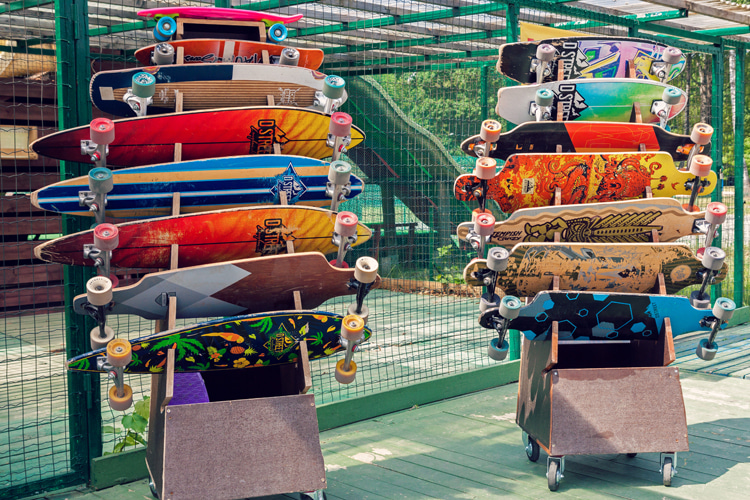In the beginning, it was just a flat wood deck and four metal wheels taken from old roller skates. Today, there are many different types of skateboards.
The evolution of skateboarding led to the development and refinement of different styles of skateboard decks.
Each one was designed to accommodate the demands of different riding conditions - performing tricks, cruising down the street, dropping in on a bowl or half-pipe, or speeding down a hill.
For example, the evolution of concave bends and kicktails increased the strength of the deck and made it a more versatile vehicle.
"Through the decades, the skateboard deck has gotten wider and then narrower, longer and shorter, and taller and lower to the ground," underlines Matt Berger, founder of Sk8Makers and author of "The Handmade Skateboard."
When it comes to size and shape, there are two main categories of skateboards: longboard skateboards and shortboard skateboards.
As a general rule of thumb, we could say short skateboards are made for tricks, and long skateboards are made for cruising.
Skateboard design has gone through various periods, eras, and phases before arriving at the most popular modern deck designs.
At the Skateboarding Hall of Fame in Simi Valley, California, skate shop owner and deck collector Todd Huber amassed a collection of more than 5,000 skateboards.
Huber's set of templates includes unique decks from the 1950s and 1960s and at least one model of every iconic skate brand from the 1970s, 1980s, 1990s, and 2000s.
You'll find four-wheel boards for all sorts of riding styles, surfaces, and skating preferences.
Let's take a look at the most popular, famous, and widely used types of skateboards that can be found rolling out on the streets.
The Mini-Cruiser Skateboard
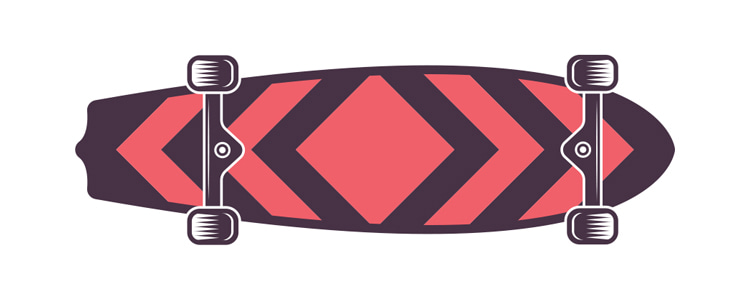
The mini-cruiser is a shorter version of the cruiser skateboard.
It's the perfect entry-level deck for young children but can also be used by intermediate skaters to cruise around town, pull off a few tricks, ride a bowl, or hit a park.
They were introduced during the sport's early days and gained a new boost and increased popularity in the 2010s.
This short and narrow design is highly portable and fits in a backpack, making it a hit among high-school students.
It comes with soft wheels and features a kick tail and a textured surface so that riders can do a few basic tricks and get around town.
They are often made from plastic and require special trucks.
The Double-Kick Popsicle Skateboard
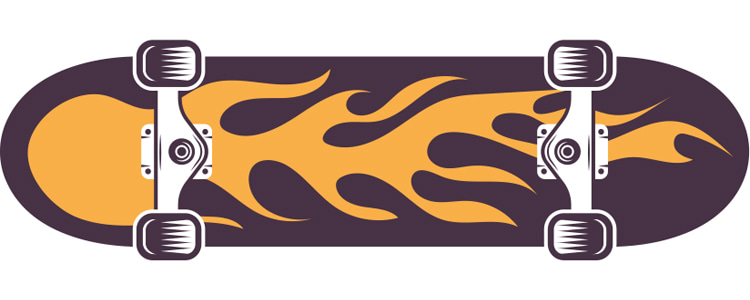
It's the standard skateboard and the most popular and widely used design. It works well on skateparks, street skating, and on almost all types of riding.
They're lightweight and a great option for those who are getting into skateboarding for the first time.
The popsicle-shaped skateboard is the go-to weapon for those wishing to perform tricks, grinding, shred curbs, and get airborne.
It features a kick in the tail and nose and a concave curve across the width.
The modern street deck is mostly symmetrical from end to end and is highly versatile when it comes to using it in multiple environments.
This 1990s design is constructed from seven layers of 1/16 inches thick hard maple veneer laminated with PVA glue and pressed from a complex form.
The Cruiser Skateboard
It's the perfect pick for transportation and short rides across the city.
They feature bigger and softer wheels to provide a comfortable ride over small cracks and rough pavement.
Compared to longboards, they allow riders to take tighter and faster turns and dodge obstacles more easily. They also feature kick tails.
The Carve Skateboard
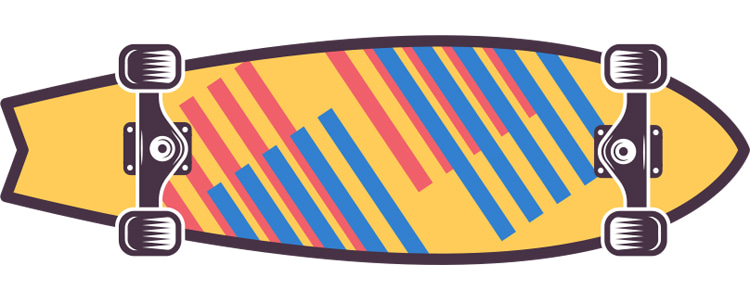
The carve skateboard is a design that generates its own speed through effortless pumping.
It was designed to mimic the surfboard's behavior on the face of the wave on flat ground.
It's a great option for practicing turns and deep carves, but it also is a favorite plank for riding a bowl.
This somehow hybrid skateboard design is becoming a popular template because it blends the characteristics of both cruisers and longboards.
The Classic Longboard Skateboard
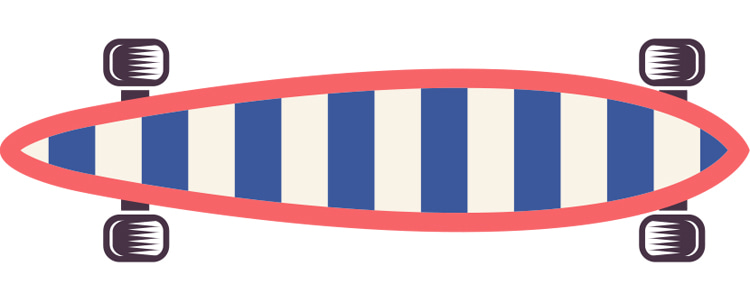
The longboard is a long and stable skateboard shaped for casual cruising on the boardwalk, fun and laid-back long-distance rides, and skating faster on more or less steep hills.
They're a good option for first-timers because they offer a large riding platform that makes it easy to learn how to balance.
But they're also a great pick for skaters of all ages and experience levels.
The most common types of longboards feature pintail or twin-tip designs.
A longboard is generally longer in length, i.e., 33 inches or more. It provides good maneuverability and allows the skater to perform wide-arched carves and turns.
It was inspired by the 1950s and 1960s longboard surfboards.
The Downhill Longboard Skateboard
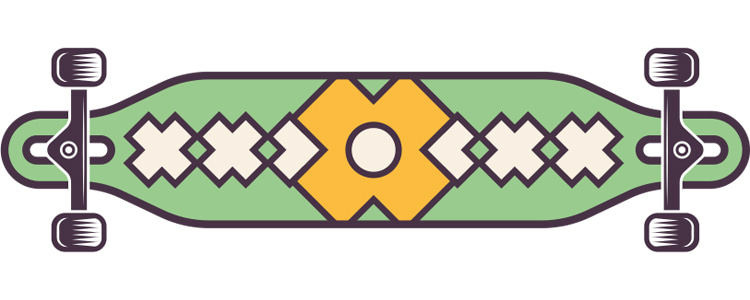
The downhill longboard is a skateboard that has been specifically designed to be ridden on steep mountain roads and slalom racing events.
It's a unique skateboard shaped for a very special purpose and delivers more stability and speed than a classic longboard skate.
When bombing hills at top speeds, skaters need a wide wheelbase and cutaway fenders that enable them to slide and control speed more safely.
You'll find two main designs when it comes to shape and contour: drop-through and standard concaves.
The Electric Skateboard
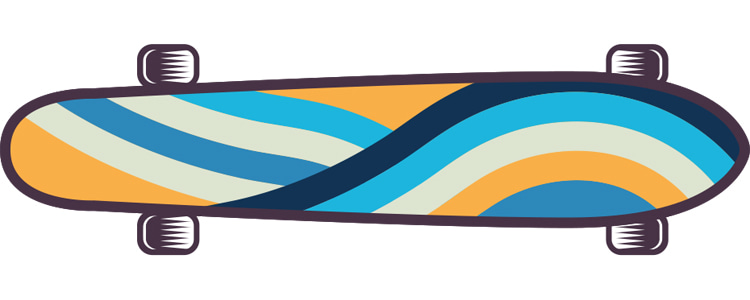
The electric skateboard is the latest addition to the list of skateboard types and designs.
One of the first variations of the pre-eSkate era was the paddle longboard, an off-road deck featuring giant all-terrain wheels and a long flexible pole with a rubber ball at the end used to propel, steer and slow the board.
The model eventually morphed into an electric-powered skateboard equipped with a small motor. The design is supposed to target young urban commuters and gadget freaks.
These motorized skateboards can travel around five miles at speeds of up to 15 miles per hour.
All a skater needs to do is move forward and backward on the deck to activate the front and rear pads.
There are also models equipped with a handheld remote that can be used to accelerate and brake the electric skate.
